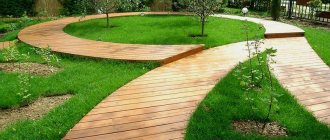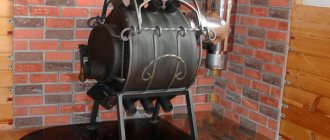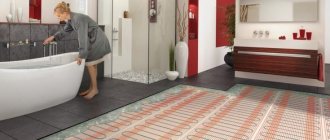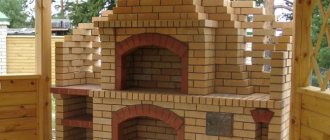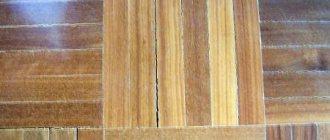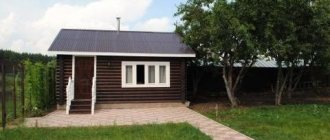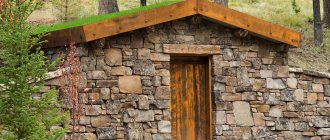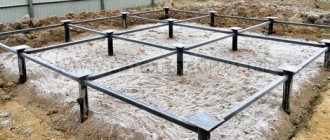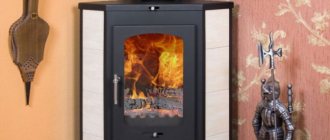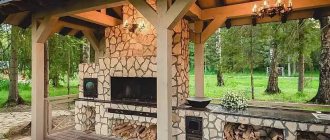Home » Equipment » Warm floor
The summer season begins in early spring and ends in late autumn. At this time, the air temperature barely reaches above zero. It's cold in the country house.
In order to spend time on the site not only usefully, but also comfortably, it is recommended to install heating in the home. Summer residents turn on heaters, but the devices require a lot of energy. They will not be able to dry the house after winter or create a favorable indoor microclimate.
The best option would be underfloor heating. What heating system should be installed in a country house? How to prepare your home for installation of a “warm floor”? What work needs to be done?
System selection
There is electricity at the summer cottage. Water is often supplied only on certain days of the week; houses are usually not connected to the gas mains. Liquid heating is installed only if the room has a stove that runs on solid fuel.
It is advisable to install water heating in a two-story house or in a cottage with a large heating area.
If the summer house does not require heating units, then electric heating elements are used as heating:
- cable section; a conductor is laid on the floor; It is recommended to cover it with a 5 cm screed or tile adhesive; for normal heating it is enough to cover 70% of the active area; Cables are not laid under furniture and household appliances; the circuit is mounted with a double “snail” or double “snake”; in this case, the cold circuit is located between the hot turns of the cable; heating is effective over the entire floor surface;
- cable mats; the system is easier to install than sections; the conductor is secured to the mesh with a snake; heating may be uneven; the further away from the power source, the cooler the cable will be;
- carbon rods; the rods are assembled into mats; installation is not difficult; cover the mats with screed or tile adhesive;
- carbon thermal film; the system is installed on any surface; laminate is immediately laid on it; for linoleum you will need to form a covering from plasterboard; the film can be covered with fiberboard or clapboard, but to cover it it is necessary to install logs and make lathing; It is not recommended to violate the integrity of carbon elements;
- electric liquid heating; a pipeline is laid on the base; it contains a heating cable; pipes are filled with propylene glycol; the coolant does not circulate through the main line; it heats up due to the cable, transfers heat to the floor; the conductor is connected to the network.
We recommend: Features of Korean heated floors
For a country house that does not have a liquid or solid fuel stove, it is recommended to install electric heating systems. They consume less energy than air heaters.
Heating can be turned off if the country house is not in use. It will take 48 hours to achieve normal thermal conditions in the premises, so it is recommended to turn on the system long before arriving at the site.
If there are frequent power outages in the area, then the optimal heating system will be a liquid circuit from the furnace. A “warm floor” in a country house is installed without a circulation pump. Pipes are brought to the floor main at an angle.
For the return pipe, the slope is made towards the boiler. The coolant circulates due to gravity. The stove is chosen to burn for a long time so that the coolant does not heat up to a high temperature.
Warm floors are the key to health
Insulating “pie”
The need for insulation in a dacha can be caused by several reasons. Basically, this correlates with the forced decision to spend a year or two at the dacha, when there are problems with housing and arrangement.
Therefore, for a family, especially those with small children, the issue of insulation is not just a functional component for comfortable living, but also an opportunity to avoid health problems.
Therefore, due attention should be paid to floor insulation. This includes issues of thermal insulation, quality of finishing materials and flooring
Typically, in country houses, the floors are made of single-layer material and, as a rule, they are wooden.
It is worth noting that wood itself can be an additional thermal insulation material. This also applies to linoleum, parquet boards or laminate.
To make the floor warmer, a layer of fiberboard or chipboard is laid underneath. But for better and more significant thermal insulation, you will have to make a lath. It is installed between the joists, and a layer of insulation is laid on top.
What is the best way to insulate a roof in a dacha?
In the process of insulating floors, it is important to use only high-quality materials, the characteristics of which include moisture resistance and reliability, light weight, strength and durability, and a low degree of thermal conductivity. . And, of course, the materials used should not cause installation difficulties
Then your dacha will quickly be transformed and will have a heated floor.
And, of course, the materials used should not cause installation difficulties. Then your dacha will quickly be transformed and will have a heated floor.
Foam insulation
Suitable insulation materials:
- extruded polystyrene foam;
- expanded polystyrene or polyurethane foam;
- perlite
- Styrofoam;
- basalt wool;
- technical jam
- porous expanded clay;
- mineral wool.
All these materials certainly have a certain function. Basalt wool helps to cope with temperature changes; it does not have flammable properties and is quite durable.
Technical cork is characterized by a high degree of environmental friendliness, but this material is quite expensive.
As for mineral wool, it is quite popular today, as it has excellent thermal insulation properties.
It is also able to repel water well. Therefore, you can purchase this material in almost any hardware store, and it is sold both in the form of flexible mats and in the form of solid slabs.
Extruded polystyrene foam has a long service life and low thermal conductivity coefficient. Therefore, this type of material is often used in underfloor heating systems.
As for expanded clay, due to its porous structure, this material can conduct almost no heat, and besides, its price is quite affordable for most summer residents.
How to prepare the house?
Regardless of whether the dacha will have heating or not, it is recommended to insulate the building. Thermal insulation material is laid on the walls, floor and roof. The insulation will keep you warm in the cold season and cool in the summer.
- It is necessary to prepare the base for laying the underfloor heating system. If the floor is not insulated, then it is opened and backfilled with expanded clay and crushed stone; layer 30 cm.
- Lay membrane waterproofing and insulation; layer 20 cm.
- A concrete screed 5 cm thick is made.
- A moisture-repellent impregnation is applied to the screed and the base is covered with insulation; thickness 5 cm.
- A damper tape is installed along the lower perimeter.
- A reflective screen is placed on the floor surface.
- The “warm floor” system is being installed.
- Perform a screed. For a liquid main, the depth is 8 cm. For a cable section or mats, it is 5 cm. Thermal film does not need a screed.
If the floor is wooden, then backfilling is done between the joists on the sheathing. Repeat all stages of preparatory work. Instead of a screed, a surface is formed from plasterboard or cement-fiber boards.
We recommend: How to assemble a Valtec manifold for heated floors?
Lay the highway on a foil backing and cover it with a wooden sheathing. The thermal film heating system is mounted directly on the wooden floor, on the lathing.
Which material to choose
The choice of insulation is determined by several criteria:
- material capabilities of dacha owners;
- complexity of installation;
- durability;
- resistance to moisture and rodents.
The last point is especially important, because if the owners live at the dacha only periodically, dampness and mice are the main reason for the destruction of the floors.
The range of insulation materials is wide, and along with modern ones, many summer residents willingly use already familiar, time-tested materials. If you have a limited budget, you can choose several acceptable options.
Expanded clay - lightweight porous granules retain heat well, mice and insects do not breed in them, and the material does not emit harmful fumes. For effective thermal insulation, it is necessary to provide reliable protection from dampness and spread expanded clay in a thick layer - up to 30 cm.
How to easily identify high-quality expanded clay
Wood shavings and sawdust are cheap and environmentally friendly materials that can be purchased at any woodworking enterprise. The shavings retain heat well, but are afraid of moisture, so they also need high-quality protection. In addition, insects and rodents can live in it.
Sawdust and shavings
Slag is an affordable and practical method of ground insulation. It also needs waterproofing, but it is durable, non-flammable and mice will not grow in it.
Slag for floor insulation
Glass wool is affordable, retains heat well and muffles sounds, and is not damaged by insects or rodents. The disadvantages include the tendency to shrink and the need to use protective agents during installation, since thin fibers are very brittle, easily penetrate the respiratory tract, and irritate the skin.
Glass wool
Polyfoam – easy to install, moisture resistant. It has a long service life, but in the absence of mice, since these rodents are very active in destroying it.
Floor insulation with foam plastic
The use of modern materials gives an incomparably better result: installation is carried out with minimal labor costs, the efficiency of insulation increases significantly, and you can forget about repeated repairs for at least 20 years. The only negative is the high price, but the financial investment fully pays off in a few years, thanks to significant savings on heating the home.
| Material | Basic properties |
| Penoplex | Eps boards are not afraid of moisture, temperature fluctuations, freezing, and thanks to their high density and special structure, they perfectly retain their shape throughout their service life. The insulation is lightweight, and the boards have a convenient connection system, so anyone can handle the installation. |
| Mineral wool insulation | Produced in various modifications, they have increased wear resistance, less hygroscopicity, and last longer. There are mats and slabs with a foil coating that reflects heat and increases the effectiveness of thermal insulation significantly. |
| Polyurethane foam | Sprayed insulation forms a dense and seamless layer of insulation that is resistant to any negative influences. Thanks to its porous structure, the insulation does not place large loads on the foundation and floors, and is excellent for thermal insulation of floors on the second floor, attic and attic. True, spraying requires a special installation, as well as skills to work with it, so insulating the floor yourself using this method is problematic. |
| Ecowool | Cellulose insulation with very low thermal conductivity. Environmentally friendly, has high sound insulation properties. The insulation is blown into the underground space using an installation, since it is quite difficult to manually evenly distribute and compact the layer. |
READ MORE: Warm floor on the balcony
rockwool mineral wool
As bulk insulation, many people use expanded vermiculite, a granular material with a scaly structure. It is lighter than expanded clay and retains heat better and serves as excellent sound insulation. Unlike EPS and mineral wool, vermiculite is completely environmentally friendly, but it is not affected by fungi, putrefactive bacteria, and insects and mice do not live in it. Well, the only disadvantages include high cost, which is why vermiculite is inferior in popularity to cotton wool insulation and polystyrene.
Expanded vermiculite
Sawdust and shavings
Glass wool
| Penoplex | Eps boards are not afraid of moisture, temperature fluctuations, freezing, and thanks to their high density and special structure, they perfectly retain their shape throughout their service life. The insulation is lightweight, and the boards have a convenient connection system, so anyone can handle the installation. |
| Mineral wool insulation | Produced in various modifications, they have increased wear resistance, less hygroscopicity, and last longer. There are mats and slabs with a foil coating that reflects heat and increases the effectiveness of thermal insulation significantly. |
| Polyurethane foam | Sprayed insulation forms a dense and seamless layer of insulation that is resistant to any negative influences. Thanks to its porous structure, the insulation does not place large loads on the foundation and floors, and is excellent for thermal insulation of floors on the second floor, attic and attic. True, spraying requires a special installation, as well as skills to work with it, so insulating the floor yourself using this method is problematic. |
| Ecowool | Cellulose insulation with very low thermal conductivity. Environmentally friendly, has high sound insulation properties. The insulation is blown into the underground space using an installation, since it is quite difficult to manually evenly distribute and compact the layer. |
"Warm floor" on a concrete base
For the liquid floor line and for the cable sections, it is necessary to provide a fastening system. The best option is reinforced mesh. It is necessary if the system is subsequently covered with screed or tile adhesive.
The floor line to the mesh is reinforced with tapes with reverse teeth. Staples, a stapler, and mounting tapes with locks are used as fastening elements.
- The ends of the liquid line are connected to the distribution comb. Pipes lead from it to the heat exchanger, which is located in the firebox. The cable is connected to the thermostat.
- No fastenings are needed for cable and carbon mats. They are produced in rolls. The rolls are rolled out over a heated area. If it is necessary to rotate the cable mat, then the mesh is cut. The conductor remains intact. The system can be rotated at any angle. To rotate the carbon mats, the connecting wire is cut. The integrity of the rods is not violated.
- The thermal film is cut along the dotted lines, forming sheets of a certain length. The distance between the sheets should be 1 cm. Secure the tape to the base with tape.
- Mats and sheets of thermal film are connected in a parallel way.
- A temperature sensor is placed on the surface of the electric floor. A niche is being created for him.
- Connect the electrical wires from the “warm floor” and the temperature sensor to the regulator.
Cold areas are left under the furniture. The distance between the turns of the cable section is 10-15 cm. The temperature regulator is installed on the wall, at a height of 40-70 cm. The sensor is placed at a distance of 30 cm from the border of the heated surface.
Pros of electric mats
What makes a warm electric floor so popular in relation to a low-temperature liquid system when it comes to a small country house or cottage?
Firstly, the ease of selection, installation and configuration of this type of heaters. Unlike a liquid system, you don't have to worry about sealing connections or dealing with pipes and fittings.
Secondly, it is possible to do without a central heat generator, a boiler, with the help of which the entire liquid heating system is heated. In this regard, electric heated floors can be compared to a heating system with electric convectors, each of which has its own control unit and a separate power supply line.
Likewise, in the case of electric heated floors, you have the opportunity to set your own temperature for each individual room.
Thirdly, when laying electrical mats or cable floors, you can do everything yourself, do it yourself. Naturally, you must understand how to install cable floors or lay electrical mats, and follow electrical safety rules.
Heating on a wooden floor
When working with wood flooring, you should always remember that the heating elements are located below the floor surface. There are several installation methods:
- the pipeline or cable sections are routed between the lags on the surface of the gypsum plasterboard; to pass the elements through the logs, holes are made; they install corrugated tubes or insulation for pipes;
- if the floor is made of boards, then a contour is drawn on the surface; For this purpose, a wall chaser is used; foil material is placed in the grooves;
- make the contour from plywood or lining; distance between workpieces 50 mm; metal thermal distribution plates are installed in the resulting niches; reflective material is placed in them;
- Thermal film is installed on a wooden floor without preliminary preparation;
- instead of concrete screed, wooden sheathing or sheets of plasterboard are used; the cladding is laid on a clean dry screed; laminate, linoleum; I'll have to give up the tiles.
We recommend: How to install Lavita underfloor heating?
When installing underfloor heating in a country house, it is necessary to provide an optimal source of energy. If possible, use a liquid line. The pipeline is filled with antifreeze. It doesn't freeze. Additionally, a circuit for DHW is output. Electric heating is provided if there are no power outages.
YouTube responded with an error: The request cannot be completed because you have exceeded your quota.
- Related Posts
- How does a water heater for underfloor heating work?
- How to repair a heated floor?
- How to install an electric heated floor?
- How does automatic floor heating work?
- Features of heated floors made of metal-plastic pipes
- How does a flow meter for a heated floor collector work?
